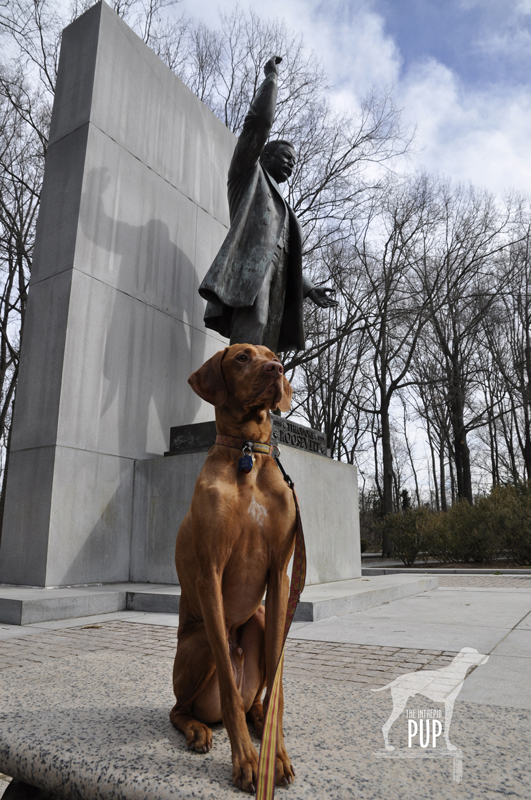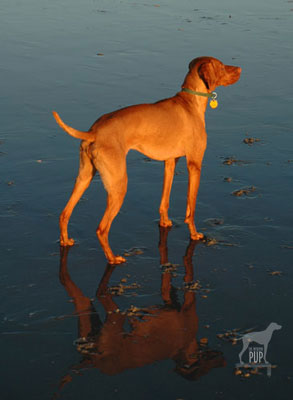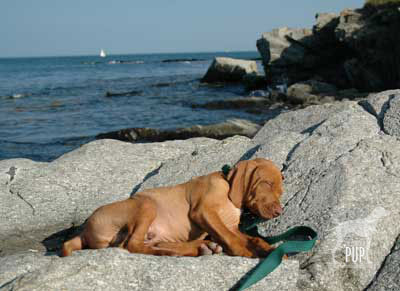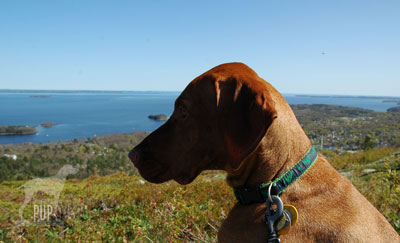 If you’re as big a fan of America’s national parks as Tavish the Intrepid Pup, then National Park Week is like having Christmas, a birthday, and the 4th of July all rolled into one. In 2012 National Park Week runs from April 21 through April 29. Jointly promoted by the National Park Service (NPS) and the National Park Foundation—the parks’ official charity—National Park Week collectively celebrates the 84 million acres preserved as “America’s best idea” by offering free admission to all 397 national park sites throughout the country. To be fair, more than 250 of these are free year-round, but in going fee free system-wide for a week, cost simply can’t be an excuse for not visiting a national park. So, in the spirit of Intrepid Pup: “Come! Adventures Await.”©
If you’re as big a fan of America’s national parks as Tavish the Intrepid Pup, then National Park Week is like having Christmas, a birthday, and the 4th of July all rolled into one. In 2012 National Park Week runs from April 21 through April 29. Jointly promoted by the National Park Service (NPS) and the National Park Foundation—the parks’ official charity—National Park Week collectively celebrates the 84 million acres preserved as “America’s best idea” by offering free admission to all 397 national park sites throughout the country. To be fair, more than 250 of these are free year-round, but in going fee free system-wide for a week, cost simply can’t be an excuse for not visiting a national park. So, in the spirit of Intrepid Pup: “Come! Adventures Await.”©
Throughout the week, Intrepid Pup will highlight various NPS sites he’s visited recently, so check back often! In the meantime, we’re starting with the Theodore Roosevelt Island National Memorial because, seriously, where better to step off National Park Week than the place dedicated to the guy who first made the environment and national parks central to domestic policy?
Theodore Roosevelt (1858-1919) became the the youngest man to ascend to the U.S. presidency, taking over when President McKinley’s term ended prematurely with an assassin’s bullet. While Roosevelt can’t lay claim to designating Yellowstone the country’s first national park (President Grant had that honor in 1872) or even to establishing the National Park Service (President Wilson got the credit in 1916), he arguably did more to shape the tenor of American resource conservation than any president before or since. During Roosevelt’s 1901-1909 tenure as the 26th president of the United States, he created five national parks and established the U.S. Forest Service. With the passage of the 1906 Antiquities Act he provided the precedent and legislative vehicle for presidents to protect historically significant sites as National Monuments…of which he then personally authorized 18. All told, among national forests, parks, game preserves, bird reservations and national monuments Roosevelt amassed a legacy of preserving a staggering 230 million acres of public land.
To visit Roosevelt Island today is to step onto a sylvan oasis. Wedged between Virginia and the District of Columbia’s banks of the Potomac River, this 88-acre dollop has had a schizophrenic past: Inhabited by 16th-century Native Americans. Overtaken by various colonials in the 18th century. Owned by George Mason (author of the Virginia Declaration of Rights) and later by his son in the early 19th century for entertaining high society in a summer house built upon its ridge. Utilized by the 1st U.S. Colored Troops as a Civil War mustering ground in 1863. Cherished as a safe haven for escaped and freed slaves fleeing the South between May 1864 and June 1865.
The Roosevelt connection didn’t come until the 1930s, when the Theodore Roosevelt Association acquired the island and promptly transferred title to the National Park Service. Initial efforts to create the only capital-area memorial to Roosevelt involved the Civilian Conservation Corps removing invasive vegetation and planting nearly 20,000 native trees. Frederick Law Olmsted Jr. (1870-1957) was enlisted to come up with an overall design. Various issues hampered progress, including World War II, and the project wasn’t resumed until the 1960s. Though Olmsted had passed away in the intervening years, many of his original ideas like a Memorial Plaza and foot trails survived the final plan put forth by Eric Gugler (1889-1974). Paul Manship (1885-1966)—perhaps better remembered for his Prometheus Fountain in New York City’s Rockefeller Center—designed the 17-foot bronze statue of Roosevelt ultimately dedicated on the site in 1967.
In Tavish’s visits to the island, we invariably begin at the expansive Memorial Plaza where Roosevelt stands at the far end, backed by a 30-foot granite shaft, right arm raised above his head as if he were in the midst of an animated speech. Four 21-foot granite tablets bear Roosevelt quotations under the headings of Nature, Manhood, Youth, and The State. Three trails (Swamp, Woods, and Upland) radiate from the plaza; none are longer than 1.3 miles. Except for a traffic helicopter’s shadow raking through the tree canopy or the dull roar of a Dc-9 following the river southward on its final approach to Ronald Reagan-Washington National Airport, you’d never believe you’re so close to the city. Don’t go expecting dazzling waterfront views; for most of the year, heavy foliage occludes shoreline panoramas of the Kennedy Center, the Watergate and Georgetown. The Potomac River is tidal but it’s fresh water that infiltrates the marshland skirting the Swamp Trail’s boardwalk. On our most recent jaunt yesterday, yellow irises were in bloom. Low tide had temporarily marooned minnows in the shallows. We spotted numerous marsh birds and encountered three deer grazing on green tendrils mere feet from the boardwalk. Two salamanders basking in the sun skittered away when we approached.
Roosevelt Island is one of five NPS sites—if you don’t count his visage on Mount Rushmore—specifically honoring our 26th President. (Intrepid Pup bonus points if you can name the others! Answers are below.*) In hiking the island, Roosevelt’s foresight for preserving parkland is readily appreciated. As one of his quotations chiseled in the nearby stone states:
“The nation behaves well if it treats the natural resources as assets
which it must turn over to the next generation increased and not impaired in value.”
Thanks, Teddy!
Dogging the Details
38°53′50.70″N, 77°3′50.22″W
Theodore Roosevelt Island National Memorial, Virginia
 By car, one can only reach the parking lot for Roosevelt Island from the northbound lanes of the George Washington Memorial Parkway. The lot serves as a trailhead for runners and cyclists on more far-flung journeys along the Mount Vernon and Potomac Heritage Trails. Though most who park here likely never cross the pedestrian bridge onto the island, the grounds nonetheless attract a fair share of walkers and joggers. Dogs are permitted on the island but must be on a 6-foot leash at all times. As always, pick up after your dog. Trash receptacles are understandably sparse along the island’s trails but are abundant in the parking area.
By car, one can only reach the parking lot for Roosevelt Island from the northbound lanes of the George Washington Memorial Parkway. The lot serves as a trailhead for runners and cyclists on more far-flung journeys along the Mount Vernon and Potomac Heritage Trails. Though most who park here likely never cross the pedestrian bridge onto the island, the grounds nonetheless attract a fair share of walkers and joggers. Dogs are permitted on the island but must be on a 6-foot leash at all times. As always, pick up after your dog. Trash receptacles are understandably sparse along the island’s trails but are abundant in the parking area.
Be aware that low-lying areas of the island flood easily, and sections of trail are seasonally boggy or otherwise closed. Consult the bulletin board on the island side of the pedestrian bridge for current trail info. Bear right and make the first left uphill to view the Memorial Plaza; otherwise stay right to embark on the Swamp Trail that encircles the island. The Island scores a “1” on the Intrepid Pup Wag-a-Meter for its easy hiking.
*The other four Roosevelt-related NPS sites are Roosevelt National Park (North Dakota), the Roosevelt Birthplace National Historic Site (New York City), Sagamore Hill National Historic Site (Oyster Bay, NY), and the Roosevelt Inaugural National Historic Site (Buffalo, NY).


 If you’ve always associated Maine with craggy shorelines, there are plenty. But you might be surprised to learn that beautiful sandy beaches can be found in coastal towns throughout southern Maine. One favorite is Kennebunk Beach. At low tide, this crescent-shaped swath of sand extends out about a hundred yards before receding into the Atlantic Ocean. Then, if you could even see this far, the next land you’d spot would be Portugal. Seriously. The surrounding communities, collectively known as the Kennebunks, are tourist magnets (particularly in the summer and fall), but Kennebunk Beach holds a year-round allure even after temperatures for swimming and sun-bathing are but distant memories. The sidewalk follows the shoreline and is great for dog-walking, complete with several waste receptacles and doggie-bag dispensers. In fact, this same scenic route along the seawall is used by the area’s Animal Welfare Society for its insanely popular (and fun) annual “Strut Your Mutt” fundraiser.
If you’ve always associated Maine with craggy shorelines, there are plenty. But you might be surprised to learn that beautiful sandy beaches can be found in coastal towns throughout southern Maine. One favorite is Kennebunk Beach. At low tide, this crescent-shaped swath of sand extends out about a hundred yards before receding into the Atlantic Ocean. Then, if you could even see this far, the next land you’d spot would be Portugal. Seriously. The surrounding communities, collectively known as the Kennebunks, are tourist magnets (particularly in the summer and fall), but Kennebunk Beach holds a year-round allure even after temperatures for swimming and sun-bathing are but distant memories. The sidewalk follows the shoreline and is great for dog-walking, complete with several waste receptacles and doggie-bag dispensers. In fact, this same scenic route along the seawall is used by the area’s Animal Welfare Society for its insanely popular (and fun) annual “Strut Your Mutt” fundraiser. Team Tavish dug back into the Intrepid Pup archives for this pic of an approximately 11-week-old Tavish on one of his very first trips to what would become a frequent destination: Peaks Island. Of the several hundred island communities that dot Casco Bay, Peaks is the most populous with ~1,100 year-round residents, though that number swells to 4,000+ during the summer months. Peaks is actually part of the City of Portland, but its history has been punctuated by various—and as yet, unsuccessful—secessionist movements. It’s accessible via a 15-minute ride from downtown Portland on the Casco Bay Lines
Team Tavish dug back into the Intrepid Pup archives for this pic of an approximately 11-week-old Tavish on one of his very first trips to what would become a frequent destination: Peaks Island. Of the several hundred island communities that dot Casco Bay, Peaks is the most populous with ~1,100 year-round residents, though that number swells to 4,000+ during the summer months. Peaks is actually part of the City of Portland, but its history has been punctuated by various—and as yet, unsuccessful—secessionist movements. It’s accessible via a 15-minute ride from downtown Portland on the Casco Bay Lines  Camden
Camden








